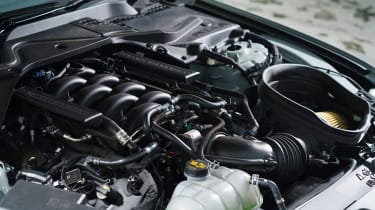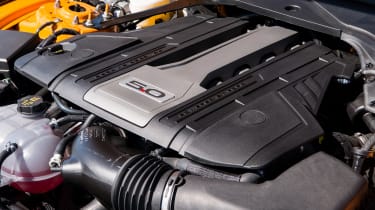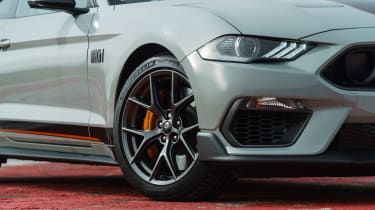Ford Mustang review – engine, transmission and technical highlights
A single 5-litre ‘Coyote’ naturally aspirated V8 engine is the only choice now available, with two transmission options
The 5-litre ‘Coyote’ V8 that powers the current Mustang has been in use by Ford since 2011, replacing the ancient 4.6-litre ‘Windsor’ that went before. On its first application in the current-gen Mustang, it produced a reasonable 410bhp, and following the car’s midlife update that figure has jumped to a 992 Porsche 911 Carrera S-matching 444bhp. The Mach 1 features an identical take on the Coyote V8, but adds a further 10bhp to the total 250rpm further up the rev range. Torque remains identical between the two at 390lb ft.
As mentioned before, the 2.3-litre turbocharged four-cylinder EcoBoost has now been removed from sale in the UK, with Ford USA citing production issues related to the chip shortage. It will likely return, though, forming an entry point to the range as it once did. Not only is the 286bhp power figure comparatively low, it’s also produced sky-high in the rev range at 5600rpm, giving you a fair idea as to the amount of turbo lag that must be fought against in reaching that number.
Both Mustang GT and Mach 1 are available with two transmission choices: a six-speed manual and a ten-speed automatic. The manual has a satisfyingly hefty shift, in keeping with the car’s rough-and-ready image. Shifts aren’t always clean though, and rush through gates and it can feel a little cumbersome and clunky.
But we now come to the automatic transmission. Launched alongside the mid-life update in 2019, the ten-speed torque converter was co-developed with General Motors in a rare show of bipartisanship between the two arch-rival companies. Spread throughout both model ranges in everything from giant F-150 pickups to the mad 600bhp Camaro ZL1, you might say that this is a troubled transmission.
More reviews
In-depth reviews
Reviews
- Ford Mustang GT 2024 review – old school in all the right ways
- Ford Mustang Dark Horse 2024 review – the last of a dying breed
- Ford Mustang Mach-E GT 2023 review – it’s fast, but is it fun?
- Used Ford Mustang (Mk6, 2015 to date) review and buyer’s guide
- Ford Mustang Shelby GT500 UK review – how does Ford’s maddest muscle car handle Blighty?
- Ford Mustang Mach 1 2021 review – America’s BMW M4 gets track fit
- Ford Mustang Steve McQueen Bullitt Edition 2021 review – a 720bhp tribute act
Its biggest problem is that like all ten-speed autos, there are just too many gears with too little difference in ratio for the car’s brain to keep up with. The car shifts so frequently that the engine barely has time to breathe, something especially prevalent given the mechanical inertia that is inherent in the V8 engine. A similar murmur could be said against other ten-speed boxes, but the Ford’s slow, slurring shifts and overactive torque converter make it feel like the car is rarely fully engaged in a gear.
Take control with the paddles and the transmission’s convoluted software is less of a problem, but the car still suffers from shudderingly slow shifts, leaving you totally unaware of whether a gear is engaged, causing the revs to flare if you apply throttle during the constant stream of shifts, then surging forward as a gear does eventually engage. It knocks your confidence in the car, never giving you any assurance as to whether the power under your right foot is connected to the road or hidden away in the driveline.
In the USA, Ford has killed off nearly all other engine variants, including the brilliant 5.2-litre ‘Voodoo’ V8 with a flat-plane crankshaft, as used in the Shelby GT350 and GT350R, but does still offer the brilliant flagship GT500, packing 760bhp from a supercharged version of the GT350’s 5.2-litre V8. It’s not just the engine that’s been to the gym, as power is sent to the same Tremec seven-speed dual-clutch transmission as in the Ford GT supercar, and boy is it a brilliant combination.
If that still doesn’t sound powerful enough, then there are plenty of tuners who will help eke out much more power from the Mustang’s 5-litre V8. One of those firms is Sutton Bespoke, which offers a range of power upgrades, from remaps to supercharger conversions. We’ve tested the CS700 and CS800, both of which are supercharged and which put out a lot more power than standard – 690bhp and 825bhp respectively. Despite significantly more power, neither seems as phenomenally fast as those figures might suggest, but the engine, chassis and visual upgrades do make the Mustang more desirable and give it real presence.






